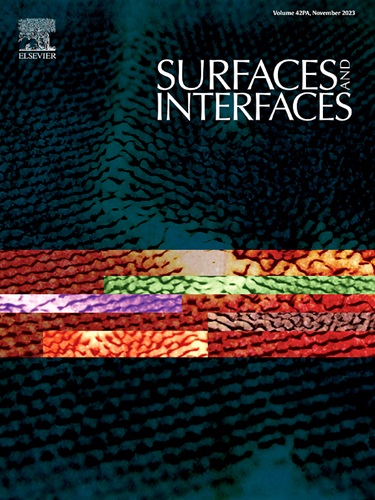双金属氧化物crbio4集成能量收集装置:向自供电接近传感器迈进了一步
IF 6.3
2区 材料科学
Q2 CHEMISTRY, PHYSICAL
引用次数: 0
摘要
摩擦电纳米发电机(TENGs)是一种创新的自供电设备,为日益增长的对灵活、经济、可持续能源的需求提供了解决方案。在本研究中,将双金属氧化铬铋(CBO)通过绿色路线合成,并作为摩擦正极材料嵌入聚乙烯醇(PVA)基体中,制备了基于聚合物复合材料的TENGs。通过简单的溶液浇铸制备了PVA-CBO薄膜,并通过SEM, EDS,介电测量和FTIR对其进行了全面表征,以证实填料分散均匀,介电常数增强,聚合物-氧化物相互作用强。该器件在7 Hz和10 n频率下的峰值电压为304.56 V,电流为2.79 μ a。该器件的实际应用通过对电解电容器充电并有效点亮一系列互连的绿色led来展示。此外,通过监测50厘米范围内的电压峰值,CBO-TENG展示了自供电接近感应能力,突出了其非接触式人机界面和安全应用的潜力。本文章由计算机程序翻译,如有差异,请以英文原文为准。

Bimetallic oxide CrBiO4-integrated energy harvesting device: A step toward self-powered proximity sensors
Triboelectric nanogenerators (TENGs) are innovative self-powered devices that offer a solution to the increasing need for flexible, cost-effective, and sustainable energy sources. In the present study, polymer‑composite based TENGs are fabricated by incorporating bimetallic chromium–bismuth oxide (CBO), synthesized via green route and embedded into a polyvinyl alcohol (PVA) matrix as tribopositive material. The PVA-CBO films are prepared via simple solution casting and thoroughly characterized by SEM, EDS, dielectric measurements, and FTIR to confirm uniform filler dispersion, enhanced dielectric constant, and strong polymer-oxide interactions. The fabricated device exhibited peak to peak voltage of 304.56 V and a current of 2.79 µA at a frequency of 7 Hz and 10 N. The practical application of this device is showcased by charging an electrolytic capacitor and effectively lighting a series of interconnected green LEDs. Moreover, by monitoring voltage peaks as a human approach within 50 cm, the CBO-TENG demonstrates self‑powered proximity‑sensing capability, highlighting its potential for non‑contact human‑machine interfaces and security applications.
求助全文
通过发布文献求助,成功后即可免费获取论文全文。
去求助
来源期刊

Surfaces and Interfaces
Chemistry-General Chemistry
CiteScore
8.50
自引率
6.50%
发文量
753
审稿时长
35 days
期刊介绍:
The aim of the journal is to provide a respectful outlet for ''sound science'' papers in all research areas on surfaces and interfaces. We define sound science papers as papers that describe new and well-executed research, but that do not necessarily provide brand new insights or are merely a description of research results.
Surfaces and Interfaces publishes research papers in all fields of surface science which may not always find the right home on first submission to our Elsevier sister journals (Applied Surface, Surface and Coatings Technology, Thin Solid Films)
 求助内容:
求助内容: 应助结果提醒方式:
应助结果提醒方式:


